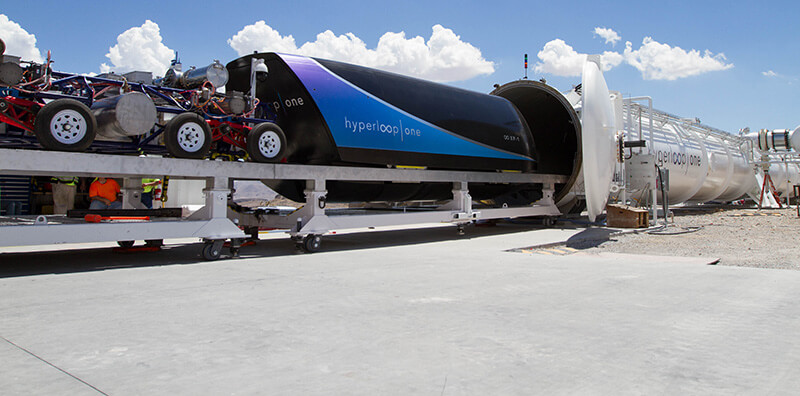 A manufacturing plant in Pittsburgh with an urgent requirement to send a pallet of freight to Chicago has few attractive options, as there is currently no direct highway route between the two. But if the visionaries at Virgin Hyperloop One have their way, that will soon change.
A manufacturing plant in Pittsburgh with an urgent requirement to send a pallet of freight to Chicago has few attractive options, as there is currently no direct highway route between the two. But if the visionaries at Virgin Hyperloop One have their way, that will soon change.
By loading the cargo into a pod inside a low-pressure ‘hyperloop’ tube that passes via Columbus, Ohio, Virgin Hyperloop One reckons it can move freight along the 490-mile (785km) route in just 47 minutes – and for around the same cost as trucking it. Given that some 5.9m tonnes of freight worth $16.7 billion moved between Columbus, Pittsburgh and Chicago in 2015, that is going to be of obvious interest to the region’s manufacturing industry.

The Pittsburgh-Columbus-Chicago route is one of ten winning hyperloop paths selected in the Virgin Hyperloop One Global Challenge, which began in May 2016 with the aim of identifying promising opportunities for hyperloop technology. Drawing together governments, quasi-governmental development bodies, engineers and urban planners, the competition saw over 2,600 teams showcase instances where improved connectivity would alleviate congestion, connect labour pools and create economic synergies.
Among the other winning routes were two in India: one linking Mumbai on the country’s west coast to Chennai on its east coast; the other between Bangalore and Chennai, at either end of the Bangalore-Chennai Industrial Corridor. Elsewhere, in Mexico, Guadalajara would be connected to Mexico City and in the UK, London would be connected to Edinburgh, and Glasgow to Liverpool.
As with Pittsburgh-Columbus-Chicago, the connection in each case would not just be between pairs of cities but would involve intermediate locations. Glasgow to Liverpool, for example, would also connect Edinburgh, Newcastle upon Tyne, Leeds and Manchester. Likewise, Bangalore to Chennai would connect Kolar, Palamaner, Chittoor and Kanchipuram.
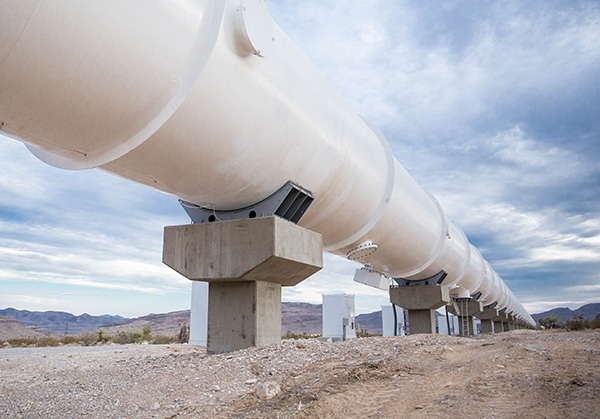
Such connectivity would prove both disruptive and transformational, says Amar Ramudhin, director of the Logistics Institute at the UK’s University of Hull. In terms of both logistics operations and economic impact, he asserts, the development of hyperloop links could transform a region’s prospects, shifting the focus of economic activity away from congested areas and unlocking the latent economic potential of parts previously poorly served by logistics links and thus starved of investment. In the UK, he points out, 60% of the population, as well as a significant proportion of the country’s manufacturing industry and warehouse space, lie north of Milton Keynes, a city just 50 miles from the centre of London, and yet 90% of the country’s inbound freight arrives through ports that are south of that line, and subsequently has to be driven north.
“So why not use the Humber ports, Liverpool and others in the north of England for incoming freight?” he asks. “This would add more resilience to the UK’s freight network and cut down on carbon emissions and possibly costs. A hyperloop could be exactly the type of technology and bold thinking that could tip the balance for freight to move to the northern ports instead.”
It’s safe to assume that connectivity on this scale, and at the speed such technology permits, would have obvious appeal for anyone with palletised freight to shift in the vicinity of a hyperloop route’s access points. Promising to send freight from London to Edinburgh in 56 minutes and from Guadalajara to Mexico City in 38 minutes at a projected cost close to that of traditional trucking, the proposition is clearly game-changing. Yet many of today’s manufacturers, 3PLs, and logistics service providers have no idea what hyperloop technology actually entails. Certainly, the technology has yet to enter mainstream consciousness.
Modern-day maglev
Despite appearances, the idea of hyperloop technology isn’t new. Back in 1909, early rocket pioneer Robert Goddard proposed something very similar. In the 1970s, meanwhile, the RAND Corporation think-tank produced a number of detailed engineering studies based on the concept. And more recently, Elon Musk – of SpaceX and Tesla fame – took up the idea, with SpaceX reportedly building a short test track.
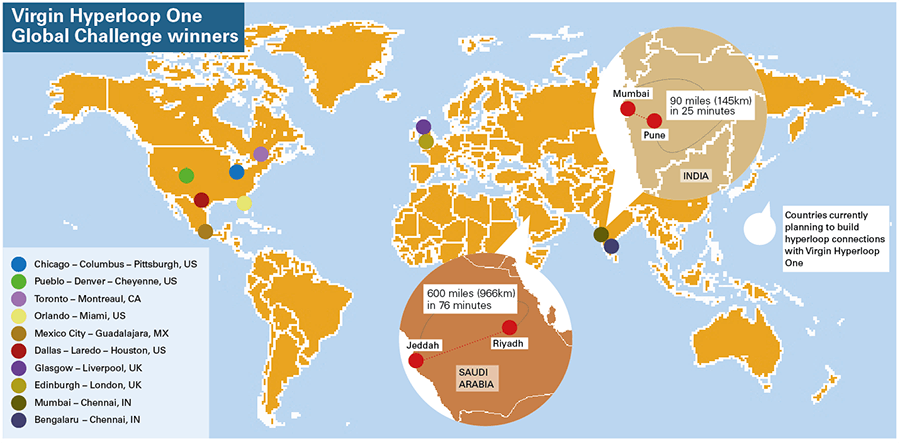 Virgin Hyperloop One Global Challenge winners – click to enlarge
Virgin Hyperloop One Global Challenge winners – click to enlargeSomewhere along the way, the original vision of hyperloop links being buried underground was reviewed, and while the hyperloop technology being advocated today by Virgin Hyperloop One can indeed be buried in tunnels, it can also be built above ground in the form of steel tubes.
A hyperloop is essentially just a tube from which most of the air has been evacuated and along which ‘pods’ are sent using magnetic levitation and linear motors. In other words, it is today’s maglev technology – but with aircraft speeds, thanks to the ultra-low aerodynamic drag when moving through the low pressure tubes.
Fully autonomous and enclosed, the technology is impervious to pilot error and weather hazards, and produces no direct carbon emissions. While tunnelling is obviously time-consuming and expensive, steel tubes above ground can be erected more quickly, just like the oil and gas pipelines that already snake huge distances across counties and continents.
It might sound like the stuff of science fiction, but hyperloop technology can already be seen working at DevLoop, Virgin Hyperloop One’s full-sized 500-metre development testbed in Clark County, Nevada.
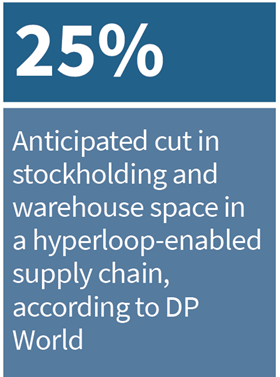
Hyperloop technology can be used to move people as well as freight, of course, but the regulatory and certification barriers to be surmounted in respect of human transport are likely to be higher than those in the way of autonomous freight transport. That said, a successful freight operation will obviously help build a case regarding the safety of hyperloop technology.
Best of both worlds
Virgin Hyperloop One chief executive Rob Lloyd points out that whereas freight transport is normally a balance between speed and cost – ground transport being relatively cheap but slow, for example – hyperloop technology should be able to offer both speed and economy. He believes it will also offer savings beyond mere reductions in transit time and shipping costs: the ability to cost-effectively ship goods quickly over long distances means that inventory replenishment lead times can be shrunk, leading to reductions in inventories and warehouse space. According to Lloyd, consulting firm McKinsey has estimated these reductions at 25%.
In short, says Lloyd, hyperloop-driven supply chains can help to deliver agile, just-in-time-based manufacturing and replenishment practices, the savings from which can dwarf any economies in shipping costs. Throw in the fact that the technology is electrically-powered and could therefore be based on renewable energy, and its transformational potential is clear, he argues.
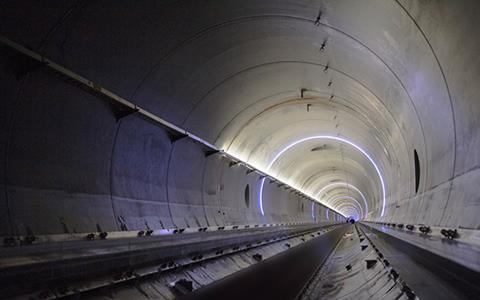
“Throughout history, cargo has always been the catalyst for transport revolutions,” notes Sultan Ahmed Bin Sulayem, DP World chairman and CEO. “We believe in Virgin Hyperloop One’s long-term vision and have made a significant investment in it because we see the need for a hyperloop-enabled cargo network to support rapid, on-demand deliveries globally. It’s the sort of transformative change that the global supply chain industry has been waiting for.”
That said, hyperloop represents the sort of transformative change that calls for deep pockets, expansive (if not visionary) thinking, and the ability to bring large-scale infrastructure projects to fruition in a meaningful timescale. All of which, according to some observers, calls for a high level of government involvement if long-distance hyperloop projects are to become a reality.
“Inevitably, it’s going to be easier to establish hyperloop links in some countries than others,” says Wolfgang Lehmacher, head of supply chain at the World Economic Forum. “China, for example, will be easier than Europe: in Europe, there are many stakeholders who must be convinced; in China, there’s just one major stakeholder [the state] to convince.”
Other observers add certain Gulf states, India and the US to the list. Lloyd confirms that Virgin Hyperloop One is working with governments and transport authorities around the world, with active projects underway with governments in the UAE, Europe, the US, Saudi Arabia and India.
Hyperloop hotspots
India, says Lloyd, is especially interesting. Today, 25% of the cargo travelling through the port of Mumbai has its origin or destination in the city of Pune, with much of it travelling along the congested Mumbai Pune Expressway. Not only could a hyperloop link reduce the journey time to a matter of minutes, he asserts, but it would also help to combine the two largest economic centres in the state of Maharashtra into a thriving, competitive mega-region.
Progress towards achieving this has been made. Already, the government of Maharashtra has signed a framework agreement with Virgin Hyperloop One to build a Pune-Mumbai hyperloop route that would link central Pune, Navi Mumbai International Airport and Mumbai in 25 minutes, connecting some 26m people. This, says Lloyd, would create a regional freight infrastructure that pre-feasibility studies have indicated could bring $55 billion in socio-economic benefits over 30 years of operation.
 From a regulatory point of view, hyperloop for freight would appear to be an easier ‘sell’ than hyperloop for passengers. Do you agree?Our Virgin Hyperloop One system doesn’t need to be passenger-only or cargo-only, but can be a mixed-use system that fully utilises capacity for both passengers and palletised freight, thus maximising the economic and social benefits. However, it’s certainly possible to run cargo commercial operations while certification and regulation is still ongoing for passenger use.
From a regulatory point of view, hyperloop for freight would appear to be an easier ‘sell’ than hyperloop for passengers. Do you agree?Our Virgin Hyperloop One system doesn’t need to be passenger-only or cargo-only, but can be a mixed-use system that fully utilises capacity for both passengers and palletised freight, thus maximising the economic and social benefits. However, it’s certainly possible to run cargo commercial operations while certification and regulation is still ongoing for passenger use.
What is the thinking on how hyperloop projects will be financed? How will construction be funded?We expect most projects to be carried out as a public-private partnership with a significant emphasis on local participation. Once a government signs an ‘intent to build’ agreement, the project starts with an in-depth feasibility study, which analyses and defines the route alignment, including the environmental impact, economicand commercial aspects of the route, and the cost and funding model recommendations.
When can we expect to see hyperloop systems in action?That depends largely on the speed of regulatory processes. So far, we are seeing a very positive response from governments to our technology, as governments understand that hyperloop offers an efficient backbone for cargo as well as passenger journeys.
For example, in February 2018, the State of Maharashtra announced its intention to build the first hyperloop route in India beginning with an operational development track. Once we commence building the demonstration track, this could take two to three years to complete, and constructing an entire route could take five to seven years.
Saudi Arabia is another country where Virgin Hyperloop One has high hopes. It is also, perhaps not entirely coincidentally, a country where decision-making powers are again concentrated in relatively few hands. According to Lloyd, hyperloop technology could connect Riyadh and Jeddah in just 76 minutes, as opposed to ten hours by road. As well as helping to position the country as a gateway to three continents, he points out, hyperloop could connect a number of major cities throughout the Middle East in under an hour. Lloyd points out that economic impact estimates suggest hyperloop links could increase the GDP of the UAE by one percentage point, and the GDP of Saudi Arabia by one to two percentage points.
Automotive implications
So what does all this mean for the world’s automotive industry? It’s difficult, at the moment, to reach any conclusions about this – not least because limited awareness of hyperloop technology among senior automotive logistics executives means that few feel qualified to comment.
Certainly, at least in North America and Western Europe, it is difficult to imagine meaningful hyperloop investments transforming the industry’s logistics operations anytime soon. It is likely to be the next generation of automotive logistics executives who will actually deal with the emergence of hyperloop links and hyperloop-enabled supply chains.
Even so, assuming that commercial hyperloop operations gain a foothold, it would be unwise for any automotive manufacturer or logistics service provider to assume they won’t then be emulated elsewhere. Seeing is believing, points out Richard Wilding, professor of supply chain strategy at Cranfield University’s Cranfield School of Management – and once the genie is out of the bottle, it will be impossible to put it back in. He believes that hyperloop technology will probably require a successful showcase operation in a far-sighted Asian or Middle Eastern nation in order to demonstrate its commercial viability.
“It takes a lot of effort to break the mould and think ‘out of the box’, and both organisations and individuals find that difficult,” he says. “There’s a tendency to think incrementally, rather than in big jumps; as Henry Ford is supposed to have remarked, if he had asked people what they wanted in an ideal transport system, they would have said ‘faster horses’. Hyperloop technology requires a leap of imagination and could be like the Channel Tunnel – stalled for decades, but an instant success once built, with supply chains configured around it.”
That said, notes Stephan Freichel, professor of distribution logistics at Köln University of Applied Sciences, the industry will have to make some adjustments if hyperloop adoption is to have a meaningful impact on automotive supply chains. Palletised freight is not a significant element of many inbound automotive supply chains, he points out, with the industry going to considerable lengths to design out pallets and switch to returnable ‘custom-fit’ packaging instead – often designed for lineside use, sequenced builds or both. Reconfiguring inbound packaging for hyperloop links can be done, but careful thought would need to be given to issues like the economics and shipment-mode of the empty return leg.
So at least to begin with, reckons Freichel, a more obvious application of hyperloop links within the industry might be aftermarket parts shipment. Central and regional distribution centres, judiciously located close to hyperloop access points, could supply parts very quickly over long distances, boosting customer service levels while simultaneously consolidating and reducing inventory holdings.
“The key question with hyperloop is the business case,” he concludes. “Freight shippers are looking for a balance of timeframe and cost. And unless that balance is correct, no mode of transport can capture market share – no matter how innovative it is. The history of transport is littered with great ideas that simply didn’t make good business sense. Will hyperloop make good business sense? We’ll have to wait and see.”
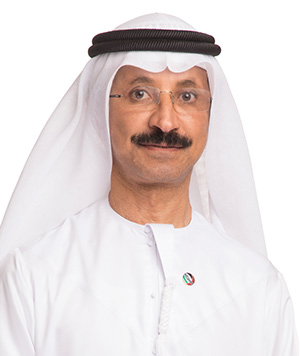 How and why did DP World come to be involved in a disruptive and innovative technology like hyperloop?We have made a significant investment in Virgin Hyperloop One because we see the need for a hyperloop-enabled cargo network to support rapid, on-demand deliveries globally. Our interest was sparked in the very early stages, and we have subsequently been a major investor and represented on the board.
How and why did DP World come to be involved in a disruptive and innovative technology like hyperloop?We have made a significant investment in Virgin Hyperloop One because we see the need for a hyperloop-enabled cargo network to support rapid, on-demand deliveries globally. Our interest was sparked in the very early stages, and we have subsequently been a major investor and represented on the board.
How will DP World Cargospeed complement your existing capabilities and operations?We believe that DP World Cargospeed is an innovative solution with great potential for revolutionising the transport of goods. It could complement our existing operations by connecting marine and inland terminals, industrial parks and free zones through another transport option. By delivering palletised cargo it can also provide for high priority, on demand goods, transporting freight at the speed of flight and closer to the cost of trucking. And the closed-system architecture offers zero weather delays, no noise restrictions and real-time tracking and scheduling.
How will DP World Cargospeed’s vision of hyperloop for freight impact on global supply chains?Air cargo currently accounts for less than 1% of world trade tonnage and yet 35% of world trade value is carried by air. We see an opportunity to expand the capacity for high priority, on-demand goods that are typically served by air – an expanding market that is currently limited by capacity challenges.
DP World Cargospeed will support the growth of on-demand, palletised cargo by delivering exceptional service for high priority, on-demand goods at much less cost and with technology that is 100% electric, and which can be powered by renewable energy, enabling a more sustainable solution for cargo transport.
Hyperloop technology doesn’t just get goods from point A to point B faster and more cheaply; it also revolutionises supply chain manufacturing. A hyperloop-enabled supply chain can help to reduce finished goods inventory by 25%, cut required warehouse space by 25% and shrink inventory lead times – gains that can add up to far more than the savings in transport costs alone, especially for high-value and time-sensitive products.
Topics
- Asia
- Canada
- DP World
- DP World
- Europe
- features
- Inbound Logistics
- India
- Inventory management
- Logistics service provider
- Mexico
- Middle East
- Nearshoring
- North America
- Packaging
- Regional Distribution Networks
- Saudi Arabia
- Service Part Logistics
- Supply Chain Planning
- United Arab Emirates
- United Kingdom
- United States Of America
- Virgin Hyperloop One


























![Global[1]](https://d3n5uof8vony13.cloudfront.net/Pictures/web/a/d/s/global1_726550.svgz)












